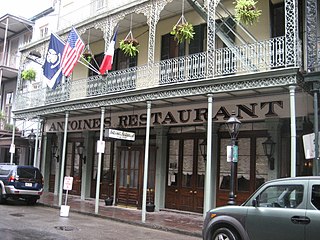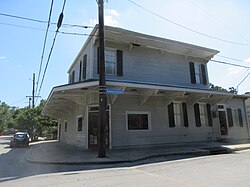
American cuisine consists of the cooking style and traditional dishes prepared in the United States. It has been significantly influenced by Europeans, indigenous Native Americans, Africans, Asians, Pacific Islanders, and many other cultures and traditions. Principal influences on American cuisine are Native American, British, German, Spanish, West African, Greek and Italian cuisines.

Cajun cuisine is a style of cooking developed by the Cajun–Acadians who were deported from Acadia to Louisiana during the 18th century and who incorporated West African, French and Spanish cooking techniques into their original cuisine.

The cuisine of the Southern United States encompasses diverse food traditions of several regions, including Tidewater, Appalachian, Lowcountry, Cajun, Creole, and Floribbean cuisine. In recent history, elements of Southern cuisine have spread to other parts the United States, influencing other types of American cuisine.

Louisiana Creole cuisine is a style of cooking originating in Louisiana, United States, which blends West African, French, Spanish, and Amerindian influences, as well as influences from the general cuisine of the Southern United States.

Gumbo is a soup popular in the U.S. state of Louisiana, and is the official state cuisine. Gumbo consists primarily of a strongly-flavored stock, meat or shellfish, a thickener, and the Creole "holy trinity" ― celery, bell peppers, and onions. Gumbo is often categorized by the type of thickener used, whether okra or filé powder.

Jambalaya is an American Creole and Cajun rice dish of French, African, and Spanish influence, consisting mainly of meat and vegetables mixed with rice.

Rémoulade is a cold sauce. Although similar to tartar sauce, it is often more yellowish, sometimes flavored with curry, and sometimes contains chopped pickles or piccalilli. It can also contain horseradish, paprika, anchovies, capers and a host of other items.

Bananas Foster is a dessert made from bananas and vanilla ice cream, with a sauce made from butter, brown sugar, cinnamon, dark rum, and banana liqueur. The butter, sugar and bananas are cooked, and then alcohol is added and ignited. The bananas and sauce are then served over the ice cream. Popular toppings also include whipped cream and different types of nuts. The dish is often prepared tableside as a flambé.

Lemon ice box pie is an icebox pie consisting of lemon juice, eggs, and condensed milk in a pie crust, frequently made of graham crackers and butter. It is a variant of key lime pie; in both, the citric acidity sets the egg yolks, with minimal baking. There are also no bake versions.

Oysters Rockefeller consists of oysters on the half-shell that have been topped with a rich sauce of butter, parsley and other green herbs, and bread crumbs, then baked or broiled. Lemon wedges are the typical garnish.

Antoine's is a Louisiana Creole cuisine restaurant located at 713 rue St. Louis in the French Quarter of New Orleans, Louisiana. It is one of the oldest family-run restaurants in the United States, having been established in 1840 by Antoine Alciatore. A New Orleans institution, it is notable for being the birthplace of several famous dishes, such as Oysters Rockefeller, pompano en papillote, Eggs Sardou and Pigeonneaux Paradis. Antoine's Cookbook, compiled by Roy F. Guste features hundreds of recipes from the Antoine's tradition. It is also known for its VIP patrons including several U.S. presidents and Pope John Paul II.
Oysters en brochette is a classic dish in New Orleans Creole cuisine. Raw oysters are skewered, alternating with pieces of partially cooked bacon. The entire dish is then broiled or breaded then either deep fried or sautéed. The traditional presentation is on triangles of toast with the skewer removed and dusted with salt and pepper or topped with either Maitre d'Hotel butter or a Meunière sauce. When prepared well, the dish should have a crispy exterior and a soft savory center with a textural contrast between the bacon and the oyster. It was usually offered on restaurant menus as an appetizer; but was also a popular lunch entrée.
The Chef John Folse Culinary Institute is an academic college of Nicholls State University in Thibodaux, Louisiana. The namesake of the college, Chef John Folse, is known as "Louisiana's Culinary Ambassador to the World".

Creole cream cheese is a form of farmer cheese that is traditional in the New Orleans area. It is made from skim milk, buttermilk and rennet, has a mild, slightly tart, slightly sweet taste, and is frequently mixed with cream, sugar and fruit and served as a dessert. It is often used to make Creole cream cheese ice cream.

Arnaud's is a Creole restaurant in New Orleans, Louisiana, United States. It serves classic Creole dishes.

The Southern Food and Beverage Museum is a non-profit museum based in New Orleans, Louisiana with a mission to explore the culinary history of the American Southern states, to explain the roots of Southern food and drinks. Their exhibits focus on every aspect of food in the South, from the cultural traditions to the basic recipes and communities formed through food.

The cuisine of New Orleans encompasses common dishes and foods in New Orleans, Louisiana. It is perhaps the most distinctively recognized regional cuisine in the United States. Some of the dishes originated in New Orleans, while others are common and popular in the city and surrounding areas, such as the Mississippi River Delta and southern Louisiana. The cuisine of New Orleans is heavily influenced by Creole cuisine, Cajun cuisine, and soul food. Seafood also plays a prominent part in the cuisine. Dishes invented in New Orleans include po' boy and muffuletta sandwiches, oysters Rockefeller and oysters Bienville, pompano en papillote, and bananas Foster, among others.

The Parish was a Cajun, Louisiana Creole, and seafood restaurant in Portland, Oregon's Pearl District, in the United States. It was opened by Tobias Hogan and Ethan Powell in 2012, and became known for its oysters. In 2015, the restaurant was split in half, and one side of the space began serving brunch, lunch, and happy hour as the Palmetto Cafe. The Palmetto was converted into a private event space and pop-up restaurant in February 2016, and The Parish closed abruptly in September of that year.















